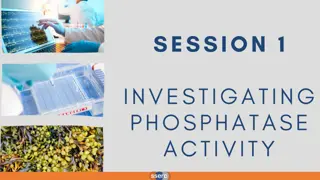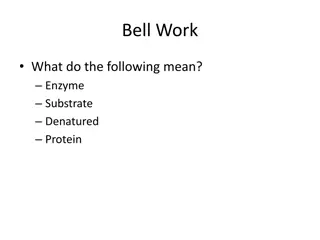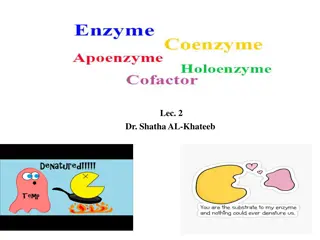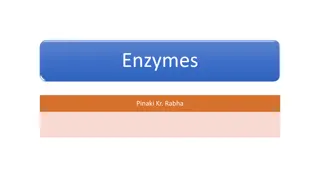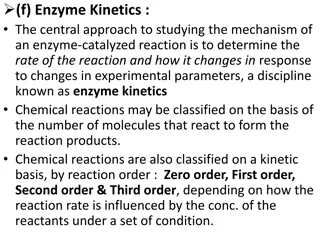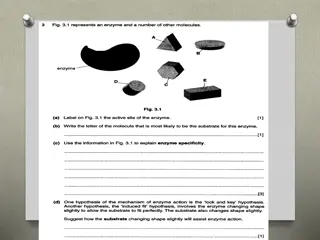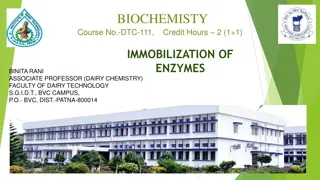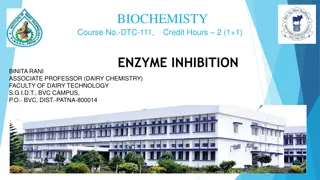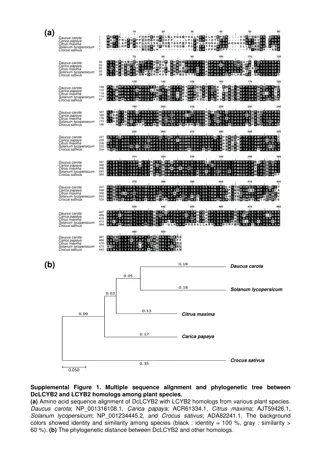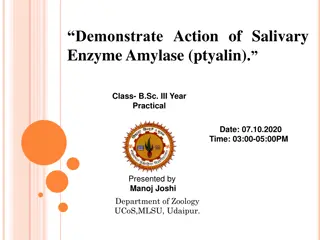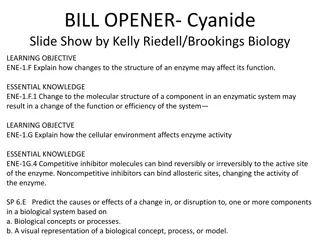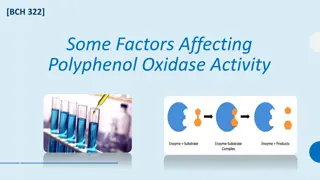
Enzyme Classification and Naming in Biochemistry
Explore the world of enzymes through systematic names, EC numbers, and enzyme classes. Learn how to interpret enzyme names, understand EC numbering, and classify enzymes based on their functions. Delve into the fascinating realm of enzyme biochemistry for a deeper understanding of biological catalysts.
Download Presentation

Please find below an Image/Link to download the presentation.
The content on the website is provided AS IS for your information and personal use only. It may not be sold, licensed, or shared on other websites without obtaining consent from the author. If you encounter any issues during the download, it is possible that the publisher has removed the file from their server.
You are allowed to download the files provided on this website for personal or commercial use, subject to the condition that they are used lawfully. All files are the property of their respective owners.
The content on the website is provided AS IS for your information and personal use only. It may not be sold, licensed, or shared on other websites without obtaining consent from the author.
E N D
Presentation Transcript
Padmavani Arts and Science College for Women, Salem-11 Department of Zoology
Trival name Gives no idea of source, function or reaction catalyzed by the enzyme. Example: trypsin, thrombin, pepsin.
Systematic Name According to the International union Of Biochemistry an enzyme name has two parts: -First part is the name of the substrates for the enzyme. -Second part is the type of reaction catalyzed by the enzyme.This part ends with the suffix ase . Example: Lactate dehydrogenase
EC number Enzymes are classified into six different groups according to the reaction being catalyzed. The nomenclature was determined by the Enzyme Commission in 1961 (with the latest update having occurred in 1992), hence all enzymes are assigned an EC number. The classification does not take into account amino acid sequence (ie, homology), protein structure, or chemical mechanism.
EC numbers EC numbers are four digits, for example a.b.c.d, where a is the class, b is the subclass, c is the sub-subclass, and d is the sub-sub-subclass. The b and c digits describe the reaction, while the d digit is used to distinguish between different enzymes of the same function based on the actual substrate in the reaction. Example: for Alcohol:NAD+oxidoreductase EC number is 1.1.1.1
The Six Classes EC 1. Oxidoreductases EC 2. Transferases EC 3. Hydrolases EC 4. Lyases EC 5. Isomerases EC 6. Ligases A list of the subclasses for each class is given below. Additional information on the sub-subclasses and sub-sub- subclasses (ie, full enzyme classification and names) can be found at the referenced web link. From the Web version, http://www.chem.qmul.ac.uk/iubmb/enzyme/index.html
EC 1. Oxidoreductases EC 1. Oxidoreductases :catalyze the transfer of hydrogen or oxygen atoms or electrons from one substrate to another, also called oxidases, dehydrogenases, or reductases. Note that since these are redox reactions, an electron donor/acceptor is also required to complete the reaction.
EC 2. Transferases EC 2. Transferases catalyze group transfer reactions, excluding oxidoreductases (which transfer hydrogen or oxygen and are EC 1). These are of the general form: A-X + B BX + A
EC 3. Hydrolases EC 3. Hydrolases catalyze hydrolytic reactions. Includes lipases, esterases, nitrilases, peptidases/proteases. These are of the general form: A-X + H2O X-OH + HA
EC 4. Lyases EC 4. Lyases catalyze non-hydrolytic (covered in EC 3) removal of functional groups from substrates, often creating a double bond in the product; or the reverse reaction, ie, addition of function groups across a double bond. A-B A=B +X-Y X Y Includes decarboxylases and aldolases in the removal direction, and synthases in the addition direction.
EC 5. Isomerases EC 5. Isomerases catalyzes isomerization reactions, including racemizations and cis- tran isomerizations.
EC 6. Ligases EC 6. Ligases -- catalyzes the synthesis of various (mostly C-X) bonds, coupled with the breakdown of energy-containing substrates, usually ATP

